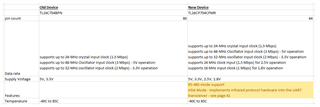Hi team, working with a customer on this. In a recent PCN, the TL16C754BPN is being replaced with TL16CP754CPMR. Please provide a list of differences or a migration guide for this.
-
Ask a related question
What is a related question?A related question is a question created from another question. When the related question is created, it will be automatically linked to the original question.


